|
Directly opposite Cedar Court is the entrance to the town’s recreational area; a wide swathe of land that includes Grange Paddocks swimming pool, the Meads and several football pitches used by local clubs. A public footpath alongside the river Stort follows its ancient course southwards towards the town, and northwards as far as Michaels Road.
The Roman road Stane Street crosses Grange Paddocks in an east-west direction, and during one of this country's rare hot summers its track beneath the parched grass was clearly visible from the air. Although the road was known to exist here, along with many building foundations from the Roman period, archaeologists had never explored the area. So, when excavation work began on foundations for the swimming pool in 1979, they watched with interest.
The site was close to the point where Stane Street would have crossed the river, and it was hoped that some evidence would be found of a Roman stone-built bridge. Disappointingly nothing was unearthed and the conclusion drawn was that a wooden bridge, or perhaps a temporary structure had been used. What the excavations did reveal though, was Roman rubbish pits containing items of pottery from the first and second centuries A.D. and a coin, a sestertius, of Sabina, wife of the Emperor Hadrian.
Even though this area has always been a flood plain, the fact that rubbish pits had been dug so close to the river indicated it must have flowed through this part of the valley then, at much the same height as it does today. It also indicated that the boundary of the Romano-British settlement, once situated on the small hill at the far side of Grange Paddocks (See Guide 10), almost certainly stretched as far as the river. MORE PICTURES
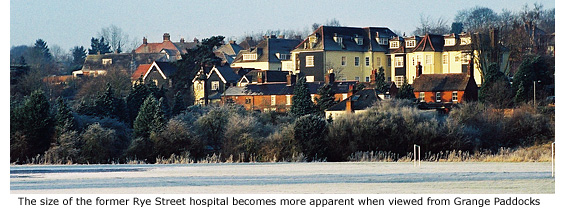
|
|
Alongside the driveway of the former Plough public house is the original boundary wall of The Grange, once home to Sir John Barker the founder of Barkers famous department store in Kensington, London, and part of a 300 acre estate he owned in the 1890s. He farmed the land here using the latest methods, bred livestock, and was famed for his polo ponies and flock of Syrian sheep.
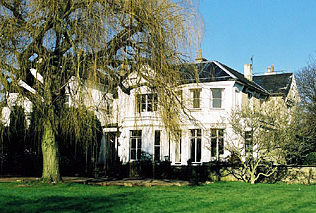 The Grange itself was sizeable. This can be judged by the present day housing development called Grange Park, built within the confines of Barker's former garden. This contained glasshouses, a carnation house and a stovehouse for orchids and palms, all maintained, it is said, by ten gardeners inside and ten gardeners outside. A hanging wall garden also once graced the western perimeter wall that still borders the entire length of Whitehall Lane. Entrance to the house itself, a large, early 19th century building now privately owned and split into apartments, is in Rye Street close to Foxdells Lane. The Grange itself was sizeable. This can be judged by the present day housing development called Grange Park, built within the confines of Barker's former garden. This contained glasshouses, a carnation house and a stovehouse for orchids and palms, all maintained, it is said, by ten gardeners inside and ten gardeners outside. A hanging wall garden also once graced the western perimeter wall that still borders the entire length of Whitehall Lane. Entrance to the house itself, a large, early 19th century building now privately owned and split into apartments, is in Rye Street close to Foxdells Lane.
Sir John Barker was born at Loose, Kent, on 6 April 1840. His father, Joseph Barker, was a carpenter and brewer, and his mother's name was Ann Sells. Privately educated, he began a three year apprenticeship to a draper in Maidstone in 1853, then gained further experience in drapery shops in Folkstone and Dover. In 1858 he moved to London where he joined Messrs Spencer, Turner, and Boldero, a firm of furnishers and drapers in Marylebone, and from there moved to William Whiteley's new emporium in Westbourne Grove. There he proved a gifted salesman and was soon promoted to department manager, doubling the store's sales as well as his own salary. He'd hoped for a partnership in the firm, but Whiteley was reluctant to relinquish sole control and instead compensated him with £1,000 per year.
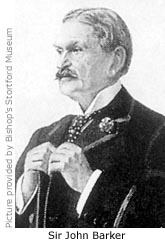 Married in 1865 to 28-year-old Sarah Waspe (d. 1903), daughter of William Waspe, 'gentleman', of Tuddenham, Suffolk, they had two children – Ann Sarah, and a son, John, who was killed in a riding accident in 1914. Barker left Whiteleys in 1870 to start his own small drapery shop in Kensington High Street, and it was from this that the famous department store Barkers of Kensington emerged. Married in 1865 to 28-year-old Sarah Waspe (d. 1903), daughter of William Waspe, 'gentleman', of Tuddenham, Suffolk, they had two children – Ann Sarah, and a son, John, who was killed in a riding accident in 1914. Barker left Whiteleys in 1870 to start his own small drapery shop in Kensington High Street, and it was from this that the famous department store Barkers of Kensington emerged.
Partnered by wealthy merchant, James Whitehead, who provided the capital and credit facilities without interfering in the business, Barker was able to exploit different modes of retailing previously used with great success at Whiteleys. By dealing directly with manufacturers and selling for cash, prices were kept down and a rapid turnover was assured. His vision of a vast store selling anything from scissors to groceries started to become a realty when he was able to buy up other premises in the area, and by 1880 he was trading from fifteen different shops in Kensington High Street and Ball Street. In 1893 he acquired Whitehead's share in the business, which now boasted sixty departments and 1400 staff, and in 1907 bought Pontin Brothers in Kensington High Street, a fashion store that had gone into liquidation.
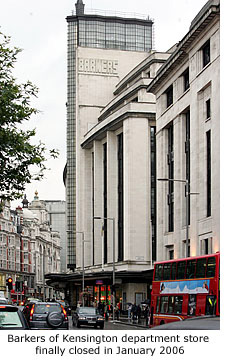 Not restricted to retailing he embarked on a political career in 1899, becoming one of the first aldermen to be elected to the new London county council. He was also president of Hammersmith Liberal Association, councillor for Chelsea Liberal Association and, locally, a member of Bishop's Stortford Working Men's Club. He contested Maidstone in 1888, 1898 and 1900, and though being elected on the third attempt was unseated on petition by the Conservatives. He did, however, sit as MP for Penryhn and Falmouth from 1906 to 1910, and in 1907 was awarded a baronetcy in Edward VII's birthday honours list. He also became a member of the Reform and National Liberal clubs, and after the Second South African War was a prominent supporter of the Territorial Movement.
Not restricted to retailing he embarked on a political career in 1899, becoming one of the first aldermen to be elected to the new London county council. He was also president of Hammersmith Liberal Association, councillor for Chelsea Liberal Association and, locally, a member of Bishop's Stortford Working Men's Club. He contested Maidstone in 1888, 1898 and 1900, and though being elected on the third attempt was unseated on petition by the Conservatives. He did, however, sit as MP for Penryhn and Falmouth from 1906 to 1910, and in 1907 was awarded a baronetcy in Edward VII's birthday honours list. He also became a member of the Reform and National Liberal clubs, and after the Second South African War was a prominent supporter of the Territorial Movement.
In the late 19th and early 20th century, Sir John helped to raise funds for the building and upkeep of Rye Street Hospital by hosting Bishop’s Stortford’s annual *Horticultural Show at The Grange. Described as one of the best flower shows in the eastern counties the event included many other attractions, including homing pigeon races, a tennis tournament, bicycle polo, dancing, and a ladies’ balloon race. Tickets for the latter cost one shilling (5p) and in 1900 the first prize was a lady’s Imperial Rover bicycle, donated by the society. That same year the Duke of York and HRH the Prince of Wales attended the show, the latter's own pigeon being one of 800 entered in the homing pigeon race. A telegram was later sent to the house from Sandringham informing him of its safe arrival! The event was always rounded off by a large firework display.
Sir John regularly entertained here, a frequent visitor being the Liberal Statesman Lloyd George, Chancellor of the Exchequer between 1908 and 1911 and Prime Minister during World War I. Sir John Barker died of cerebral thrombosis and heart failure on 16 December 1914 here at The Grange, leaving no heir.
*Known as one of the poshest department stores in London, Barkers of Kensington finally closed its doors to the public in January 2006 after 135 years of trading. House of Fraser, owners of the store since 1975, said it no longer fitted in with their portfolio, partly due to a change in shopping patterns in London. What they meant by this was: despite housing such designers as Dolce and Gabbana and Versace, Kensington can no longer compete with the West End as a destination for clothes shopping. The bottom three floors of the Art Deco building (lower ground, ground and first), have been taken over by the American natural food company, Whole Foods Market, to become Britain's first organic and health food supermarket, while the top floors are already occupied by Associated Newspapers.
*The Horticultural Show was transferred to Silver Leys in 1915, where it remained an annual event for many years (See Guide 5 - Silver Leys).
In the late 19th and early 20th century, virtually all of the land in this area, including that between Rye Street and the river, was part of the Gilbey estate. Wrought iron railings that once topped the entire length of the roadside wall have now mostly disappeared and the wall has been vandalised, but two brick pillars remain opposite Foxdells Lane indicating the former entrance to Grange Paddocks stables. MORE PICTURES
|
|
In the 1930s, and maybe for some years before, a piece of land bordered by Rye Street, Cannons Mill Lane, Bourne Brook and Grange Paddocks, now known as Meadowlands, was owned by one Frank Stock. He sold it for development in August 1937 to Harold Bradshaw and Clifford Sears, and in August 1938 they sold all or part of the land to one Eric Haywood. Conditions of the sale were that the site was to be used for the erection of private houses, each to cost not less than £500 (including land), and the vendors would not be responsible for trespass of cattle sheep and horses from their adjoining land. The site and the development was originally called The Meadowlands.
At the ending of the Second World War, the Herts & Essex Observer, dated 2 June 1945, reported the following:
A VE Party for the children and adults in North Rye Street was held in Meadowlands on Saturday [26 May], approximately 100 being present. Mr Tresham Gilbey lent a marquee, which proved very useful in the showery weather, holding all for tea, entertainment and supper. The marquee was illuminated by festoons of coloured lighting. The party was arranged and organised by Mrs F. Maslen, who had the complete support and help of all residents in the block, providing more than sufficient food and delicacies. They also contributed £8 5s for prizes and awards. Races and competitions were organised in Mr Edwards' meadow for the youngest and the oldest. Each of the 60 children was given a shilling [5p] on leaving. The day ended with fireworks. The surplus money was given – 20s. to the Red Cross and 30s. to the Hospital.
|
|
Formerly known as Parsonage Mill Lane, this narrow road leads to a long, single-storey building that was originally a stable block used by Tresham Gilbey, and where, for a brief time early last century, he kept his polo ponies. Much later the stables became home to a riding school, but when this closed in the mid 1980s the buildings fell into disrepair and remained as such until the site was bought by a property developer and converted into the present offices.
The lane continues on the other side of the London to Cambridge railway line as a wide footpath before opening out into Millcroft, a small housing development built in the 1970s. All of the land here, stretching south as far as Parsonage Lane, was once owned by Parsonage Mill Farm – the original farm house still standing a short distance into Millcroft. It has since been renamed Parsonage Mill, but the actual mill stood alongside the river a short distance away. In the late 18th century the miller was William Waylett, whose son, also named William, worked here as a boy and later owned the windmill at Hockerill (See Guide 10). The river was naturally much wider at that time, but development and encroaching vegetation along its banks have now turned it into little more than a stream. MORE PICTURES
|


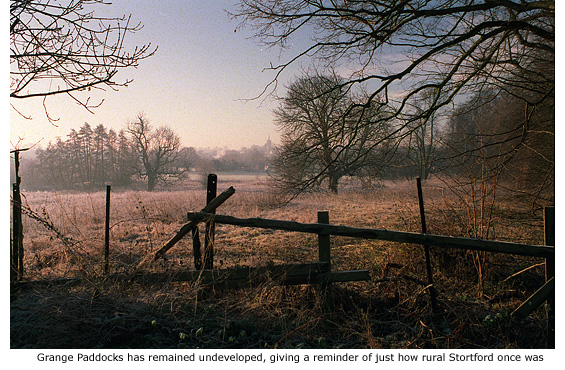
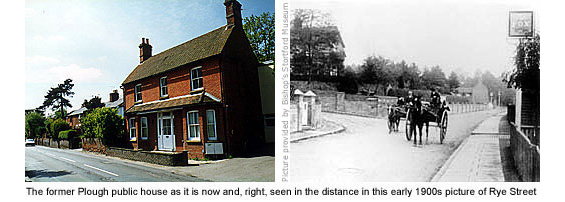
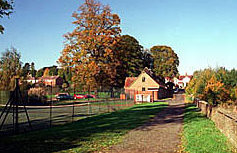
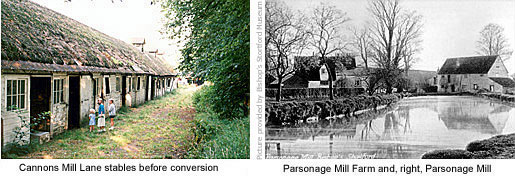


 The Grange itself was sizeable. This can be judged by the present day housing development called Grange Park, built within the confines of Barker's former garden. This contained glasshouses, a carnation house and a stovehouse for orchids and palms, all maintained, it is said, by ten gardeners inside and ten gardeners outside. A hanging wall garden also once graced the western perimeter wall that still borders the entire length of Whitehall Lane. Entrance to the house itself, a large, early 19th century building now privately owned and split into apartments, is in Rye Street close to Foxdells Lane.
The Grange itself was sizeable. This can be judged by the present day housing development called Grange Park, built within the confines of Barker's former garden. This contained glasshouses, a carnation house and a stovehouse for orchids and palms, all maintained, it is said, by ten gardeners inside and ten gardeners outside. A hanging wall garden also once graced the western perimeter wall that still borders the entire length of Whitehall Lane. Entrance to the house itself, a large, early 19th century building now privately owned and split into apartments, is in Rye Street close to Foxdells Lane. Married in 1865 to 28-year-old Sarah Waspe (d. 1903), daughter of William Waspe, 'gentleman', of Tuddenham, Suffolk, they had two children – Ann Sarah, and a son, John, who was killed in a riding accident in 1914. Barker left Whiteleys in 1870 to start his own small drapery shop in Kensington High Street, and it was from this that the famous department store Barkers of Kensington emerged.
Married in 1865 to 28-year-old Sarah Waspe (d. 1903), daughter of William Waspe, 'gentleman', of Tuddenham, Suffolk, they had two children – Ann Sarah, and a son, John, who was killed in a riding accident in 1914. Barker left Whiteleys in 1870 to start his own small drapery shop in Kensington High Street, and it was from this that the famous department store Barkers of Kensington emerged. Not restricted to retailing he embarked on a political career in 1899, becoming one of the first aldermen to be elected to the new London county council. He was also president of Hammersmith Liberal Association, councillor for Chelsea Liberal Association and, locally, a member of Bishop's Stortford Working Men's Club. He contested Maidstone in 1888, 1898 and 1900, and though being elected on the third attempt was unseated on petition by the Conservatives. He did, however, sit as MP for Penryhn and Falmouth from 1906 to 1910, and in 1907 was awarded a baronetcy in Edward VII's birthday honours list. He also became a member of the Reform and National Liberal clubs, and after the Second South African War was a prominent supporter of the Territorial Movement.
Not restricted to retailing he embarked on a political career in 1899, becoming one of the first aldermen to be elected to the new London county council. He was also president of Hammersmith Liberal Association, councillor for Chelsea Liberal Association and, locally, a member of Bishop's Stortford Working Men's Club. He contested Maidstone in 1888, 1898 and 1900, and though being elected on the third attempt was unseated on petition by the Conservatives. He did, however, sit as MP for Penryhn and Falmouth from 1906 to 1910, and in 1907 was awarded a baronetcy in Edward VII's birthday honours list. He also became a member of the Reform and National Liberal clubs, and after the Second South African War was a prominent supporter of the Territorial Movement.